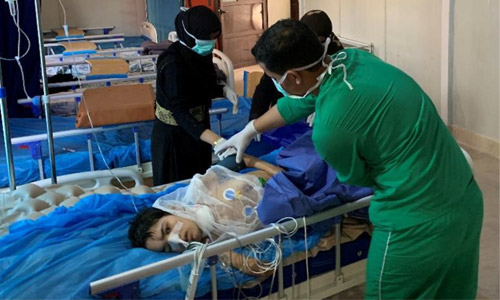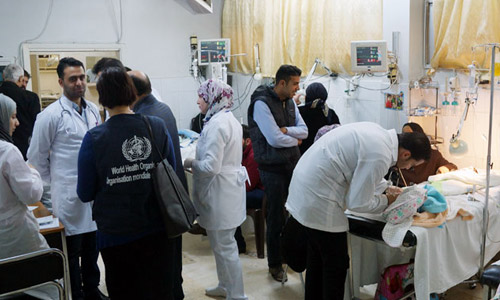Explosive remnants of war will continue be a threat to individuals, especially children, and strain the health system in Syria for years to come. A national household survey carried out in June 2019 found that over half of all households surveyed had a member who was living with a disability and almost half of households surveyed had two or more members who were living with a disability. The report also found that 27% of people aged 12 and above had a disability. Today’s and future victims will require comprehensive care, including trauma services, mental health support and long-term rehabilitation. To help maintain access to trauma stabilization and emergency surgical care services, WHO donated 21 ambulances to the MoH and the Syrian Arab Red Crescent, and supported five field surgical units in rural Hama governorate that stabilized 4112 patients, including 2547 who required immediate surgical intervention before being referred to nearby hospitals.

In northwest Syria, WHO’s office in Gaziantep delivered specialized trauma and surgical kits and medicines to provide more than 180 000 treatments. In areas accessible from within Syria, WHO supported trauma care for 474 669 patients and delivered 2 354 029 courses of treatment and 108 pieces of medical equipment to health facilities providing trauma care services. A total of 2571 health care workers were trained on trauma care, treatment of patients with disabilities, first aid, prostheses, basic life support, mass casualty events, burns, war wounds and spinal cord injuries. WHO also supported 22 000 physiotherapy sessions and delivered nearly 2300 disability devices.
In the northeast, WHO renewed its agreement with Al-Hekma hospital and signed an agreement with Al Hayat private hospital in Al-Hasakeh governorate to cover the costs of patients admitted for trauma and emergency care. By the end of 2019, the two hospitals had provided 5780 treatments. In October2019, WHO signed an agreement with a third hospital (Al-Teb Al-Hadeeth) in Ar-Raqqa city. A team of physicians from the Bambino Gesù paediatric hospital in Rome re-visited Syria in 2019 to continue training their counterparts in university hospitals inDamascus and Aleppo on the latest techniques inlaparoscopy, interventional radiography, paediatric catheterization, intensive care and cardiovascularsurgery. A total of 24 doctors and 20 nurses from four university hospitals in Damascus and Aleppo were trained. Subsequently, the Syrian physicians visited the Italian hospital and later returned to Syria to train other specialists in their hospitals.

In northwest Syria, WHO’s office in Gaziantep delivered specialized trauma and surgical kits and medicines to provide more than 180 000 treatments. In areas accessible from within Syria, WHO supported trauma care for 474 669 patients and delivered 2 354 029 courses of treatment and 108 pieces of medical equipment to health facilities providing trauma care services. A total of 2571 health care workers were trained on trauma care, treatment of patients with disabilities, first aid, prostheses, basic life support, mass casualty events, burns, war wounds and spinal cord injuries. WHO also supported 22 000 physiotherapy sessions and delivered nearly 2300 disability devices.








